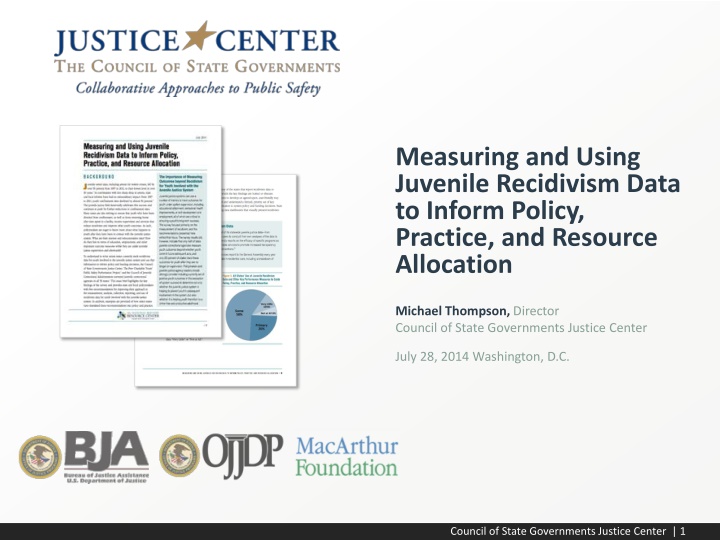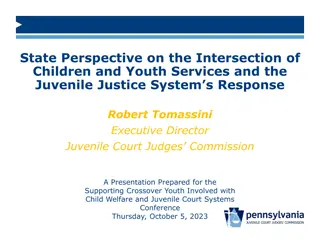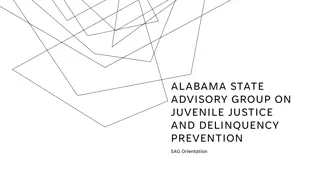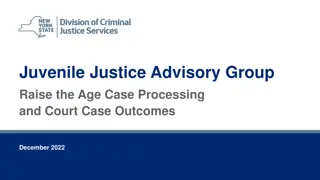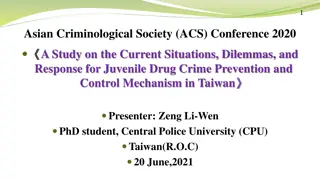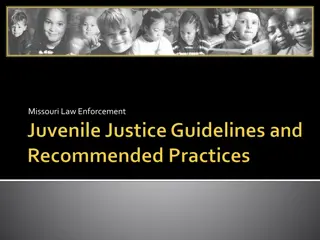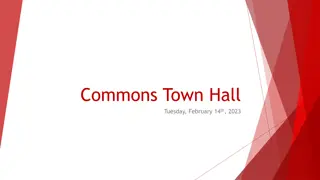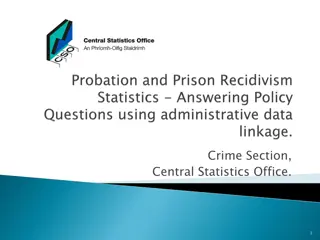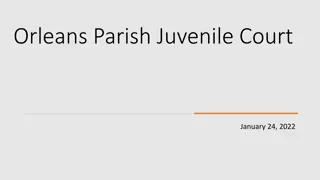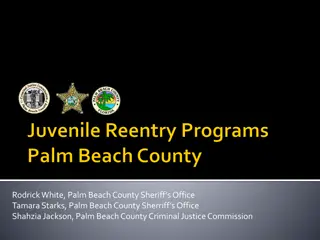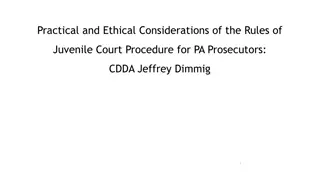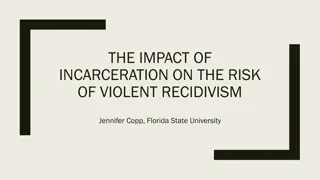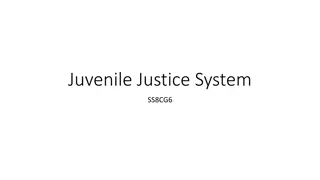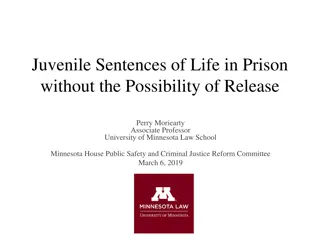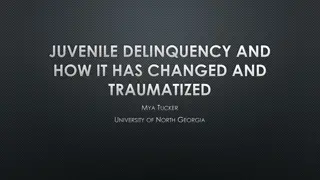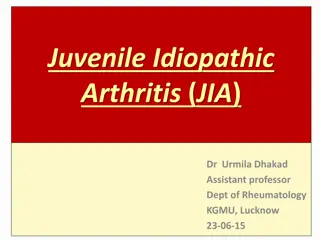Tracking Juvenile Recidivism Data for Informed Policy and Practice
This presentation discusses the importance of tracking juvenile recidivism data to inform policy, practice, and resource allocation in the juvenile justice system. It highlights the need for comprehensive data analysis, key recommendations, and core principles for reducing recidivism among youth. The content emphasizes the significance of measuring recidivism for all youth involved in the justice system and utilizing the data to improve outcomes for juveniles.
Download Presentation

Please find below an Image/Link to download the presentation.
The content on the website is provided AS IS for your information and personal use only. It may not be sold, licensed, or shared on other websites without obtaining consent from the author.If you encounter any issues during the download, it is possible that the publisher has removed the file from their server.
You are allowed to download the files provided on this website for personal or commercial use, subject to the condition that they are used lawfully. All files are the property of their respective owners.
The content on the website is provided AS IS for your information and personal use only. It may not be sold, licensed, or shared on other websites without obtaining consent from the author.
E N D
Presentation Transcript
Measuring and Using Juvenile Recidivism Data to Inform Policy, Practice, and Resource Allocation Michael Thompson, Director Council of State Governments Justice Center July 28, 2014 Washington, D.C. Council of State Governments Justice Center | 1
Dramatic Progress But More Work Needed National Arrests Per 100,000 Juveniles Ages 10-17 (1980-2011) Declines in State Commitment Rates (1997-2011) 0% 9000 -10% 8000 -20% -30% 7000 -40% -50% 6000 -48% -51% -60% 5000 Decrease From -70% -68% -72% Peak -80% 4000 -77% -78% -79% -90% 3000 -100% 1980 1986 1992 1998 2004 2010 National Avg. Connecticut Georgia Mississippi Rhode Island Tennessee *Easy Access to the Census of Juveniles in Residential Placement, Office of Juvenile Justice and Delinquency Prevention *Juvenile Arrest Rates for All Crimes, 1980-2011, Office of Juvenile Justice and Delinquency Prevention Council of State Governments Justice Center | 2
Most states are not sufficiently tracking recidivism data for youth under the custody of their state juvenile correctional agency Does your state track recidivism for youth in state custody? Into adult criminal justice system Of the 39 states, how many track recidivism in more than one form of contact with the justice system? 31 Yes No 29 Technical violations of parole 24 Re-arrests 39 23 12 Offense Needs Of the 39 states, how many analyze recidivism according to? 11 Length of stay Locale 23 12 21 11 Risk level Program Council of State Governments Justice Center | 3
Key Recommendations Measure recidivism for all youth involved with the juvenile justice system, considering the multiple ways they may have subsequent contact with the justice system Analyze recidivism data to account for youth s risk levels, as well as other key youth characteristics and variables Develop and maintain the infrastructure necessary to collect, analyze, and report recidivism data Make recidivism data available to key constituents and the general public Use recidivism data to inform juvenile justice policy, practice, and resource allocation Council of State Governments Justice Center | 4
Core Principles for Reducing Recidivism and Improving Other Outcomes for Youth in the Juvenile Justice System Michael Thompson, Director Council of State Governments Justice Center July 28, 2014 Washington, D.C. Council of State Governments Justice Center | 5
How to Use the White Paper Develop a full understanding of what works Integrate distinct improvement strategies Operationalize these principles with fidelity to the research Assess current efforts and measure progress towards improvement Council of State Governments Justice Center | 6
Core Principles Principle 1 Principle 2 Principle 3 Principle 4 Base supervision, service, and resource allocation decisions on the results of validated risk and needs assessments. Adopt and effectively implement programs and services demonstrated to reduce recidivism and improve other youth outcomes, and use data to evaluate the results and direct system improvements. Employ a coordinated approach across service systems to address youth s needs. Tailor system policies, programs, and supervision to reflect the distinct developmental needs of adolescents. Council of State Governments Justice Center | 7
White Paper and Issue Brief in Action Piloting issue brief recommendations to help state systems track recidivism and use this data to guide system decisions and hold agencies accountable. Piloting white paper checklists to help state systems assess and strengthen policies and practices to improve outcomes for youth KS NE TN NE PA UT Council of State Governments Justice Center | 8
Texas Juvenile Outcome Study Michael Thompson, Director Council of State Governments Justice Center July 28, 2014 Washington, D.C. Council of State Governments Justice Center | 9
Dramatic Decline in Youth Committed to State Incarceration in Texas Total Texas Admissions to State Facilities (FY 2002 FY 2012) 4,000 2011 Legislature 3,500 Merge former TX Youth Commission and TX Juvenile Probation Commission into Texas Juvenile Justice Department (TJJD) 3,000 2007 Legislature No commitment for misdemeanor offenses; $60 million in new community funding 2,500 2,000 1,500 2009 Legislature 1,000 $45 million for Commitment Reduction Program with incentive funding for counties and community supervision 500 0 2002 2003 2004 2005 2006 2007 2008 2009 2010 2011 2012 Council of State Governments Justice Center | 10
High State-Wide Recidivism Rates: Impact of Reforms on Recidivism a Significant Concern Re-Arrest Rate 100% 85% 90% 79% 78% 80% 67% 70% Re-Arrest Rate of Probationers 60% 45% 50% 36% 40% Re-Arrest Rate For Youth Released From State Facilities 30% 20% 10% 0% One-Year Rate (2011 Group) Three-Year Rate (2010 Group) Five-Year Rate (2008 Group) Council of State Governments Justice Center | 11
High State-Wide Recidivism Rates (continued) Incarceration Rate 100% 90% 80% Incarceration Rate of Probationers 70% 60% 54% 49% 50% 40% Incarceration Rate For Youth Released From State Facilities 30% 24% 20% 20% 14% 10% 4% 0% One-Year Rate (2011 Group) Three-Year Rate (2010 Group) Five-Year Rate (2008 Group) Council of State Governments Justice Center | 12
Reforms Shifted Funding from Incarceration to Community-Based Interventions 2004-2005 Biennial Budget 2014-2015 Biennial Budget $260.7 Million $327.2 Million $472.1 Million $289.9 Million Institutions Community Institutions Community Average Daily Population in State Correctional Facilities: 4,910 Average Daily Population in State Correctional Facilities: 1,066 Council of State Governments Justice Center | 13
Texas Juvenile Justice Study Questions To what extent were the policy reforms effective in reducing the number of youth in state-run correctional facilities? Are recidivism rates lower for the types of youth who used to be incarcerated in state correctional facilities, but who today are diverted from such incarceration settings? How do recidivism rates compare from one community-based intervention to the next? What might explain variations in recidivism rates among similar youth placed in under community supervision? Council of State Governments Justice Center | 14
Most Extensive Data in the Country for the Study 487,602 Youth and 850,434 Records Tracked 2005 2006 2011 2012 2013 2008 2009 2010 2007 Juveniles Released from Secure State Facilities Juveniles Placed on Deferred Prosecution or Probation Supervision Incorporates Data From: Texas Department of Juvenile Justice Case Records of Juveniles and State and County Expenditures Data Texas Department of Public Safety County Probation Departments Population characteristics include demographics, County Placement, Program Participation, Referral / Disposition Arrest trend data and criminal history files for each juvenile Practices in eight county probation departments Council of State Governments Justice Center | 15
December 2014 release will have major impact both in Texas and nationally Texas legislature will examine study findings in January 2015 and use results to inform major policy decisions Study will guide national conversation as states who have reduced number of kids in secure confinement seek to understand better what policies and investments are effective in reducing subsequent contact with juvenile justice system Council of State Governments Justice Center | 16
Thank You Join our distribution list to receive CSG Justice Center project updates! www.csgjusticecenter.org/subscribe For more information, contact Josh Weber (jweber@csg.org) The presentation was developed by members of the Council of State Governments Justice Center staff. The statements made reflect the views of the authors, and should not be considered the official position of the Justice Center, the members of the Council of State Governments, or the funding agency supporting the work. Citations available for statistics presented in preceding slides available on CSG Justice Center web site. Council of State Governments Justice Center | 17
